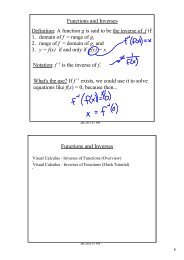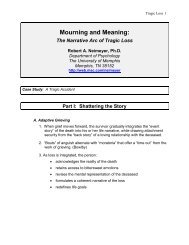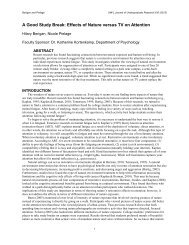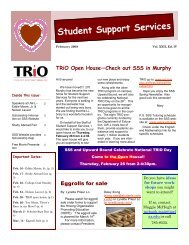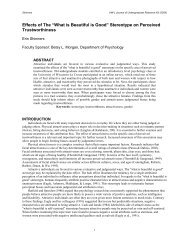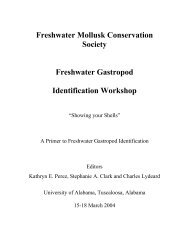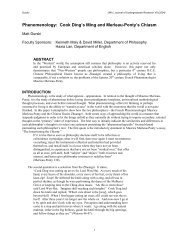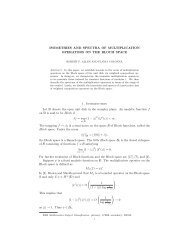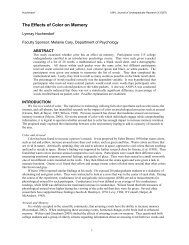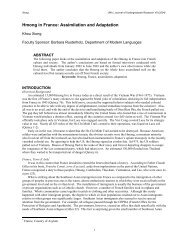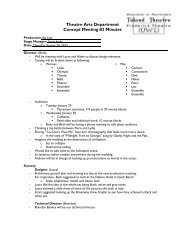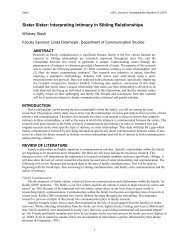The Mesopotamian Origins of the Hittite Double-Headed Eagle
The Mesopotamian Origins of the Hittite Double-Headed Eagle
The Mesopotamian Origins of the Hittite Double-Headed Eagle
You also want an ePaper? Increase the reach of your titles
YUMPU automatically turns print PDFs into web optimized ePapers that Google loves.
chariton UW-L Journal <strong>of</strong> Undergraduate Research XIV (2011)<br />
<strong>The</strong> <strong>Mesopotamian</strong> <strong>Origins</strong> <strong>of</strong> <strong>the</strong> <strong>Hittite</strong> <strong>Double</strong>-<strong>Headed</strong> <strong>Eagle</strong><br />
Jesse D. Chariton<br />
Faculty Sponsor: Mark W. Chavalas, Department <strong>of</strong> History<br />
ABSTRACT<br />
<strong>The</strong> figure <strong>of</strong> a double-headed bird is represented in many cultures around <strong>the</strong> globe, and in<br />
various time periods. “<strong>The</strong> double-headed eagle has been a royal symbol throughout its history<br />
until <strong>the</strong> present day” (Deeds 1935:106). <strong>The</strong> history <strong>of</strong> <strong>the</strong> use <strong>of</strong> <strong>the</strong> double-headed eagle in<br />
various contexts since <strong>the</strong> Crusades has been well documented. It has been used as a heraldic<br />
emblem <strong>of</strong> many royal houses, and is still a state symbol in some countries. However, ancient<br />
Near Eastern cultures had used <strong>the</strong> double-headed bird motif millennia before <strong>the</strong> Crusades. One<br />
striking example is that <strong>of</strong> <strong>the</strong> <strong>Hittite</strong>s, for whom it was a “royal insignia” (Collins 2010:60). This<br />
paper explores <strong>the</strong> <strong>Mesopotamian</strong> origins <strong>of</strong> <strong>the</strong> double-headed eagle motif as used by <strong>the</strong> <strong>Hittite</strong>s.<br />
Keywords: double-headed eagle, <strong>Hittite</strong>, comparative iconography<br />
INTRODUCTION<br />
<strong>The</strong>re has been little research on <strong>the</strong> use <strong>of</strong> <strong>the</strong> double-headed eagle motif before <strong>the</strong> Common Era. Some<br />
research has been done on double-headed animal imagery (Mundkur 1984), but generally it is part <strong>of</strong> a broader study<br />
(e.g. Mollier 2004). Rudolf Wittkower, in his study <strong>of</strong> <strong>the</strong> eagle and snake motif, gives passing mention <strong>of</strong> <strong>the</strong><br />
double-headed eagle in a footnote, indicating that it was out <strong>of</strong> <strong>the</strong> scope <strong>of</strong> his article and directing <strong>the</strong> reader to<br />
“relevant material” in o<strong>the</strong>r articles (Wittkower 1939:Note 10).<br />
That <strong>the</strong> double-headed eagle motif appears on <strong>Hittite</strong> monuments in central Anatolia has been cited since <strong>the</strong>ir<br />
discovery by Charles Texier in <strong>the</strong> early 19th century. Modern historians have simply claimed that <strong>the</strong> monumental<br />
art <strong>of</strong> <strong>the</strong> <strong>Hittite</strong>s was so impressive that it was copied by later peoples for <strong>the</strong>ir coats <strong>of</strong> arms. But that is <strong>the</strong> end <strong>of</strong><br />
it—or <strong>the</strong> beginning <strong>of</strong> <strong>the</strong> double-headed eagle image—for <strong>the</strong>m. In 1923 Arthur C. Parker, an American<br />
anthropologist and historian wrote an influential article, “<strong>The</strong> <strong>Double</strong>-<strong>Headed</strong> <strong>Eagle</strong> and Whence it Came,” in which<br />
he acknowledges a <strong>Mesopotamian</strong> precursor to that <strong>of</strong> <strong>the</strong> <strong>Hittite</strong>s.<br />
Although Balaji Mundkur‟s 1984 article “<strong>The</strong> Bicephalous „Animal Style‟ in Nor<strong>the</strong>rn Eurasian Religious Art<br />
and Its Western Hemispheric Analogues” was specifically a study <strong>of</strong> double-headed animals, it was broad in scope,<br />
including animals as well as birds, and was not focused on iconography: “Aboriginal zoomorphic art <strong>of</strong> nor<strong>the</strong>rn<br />
Eurasia and <strong>the</strong> New World…need not exhibit visually striking resemblances” (Mundkur 1984:474). Mundkur was<br />
more interested in interpretation—in cross-cultural “primordial religious attitudes” across a very wide geographical<br />
area.<br />
Two <strong>of</strong> Mundkur‟s points served as <strong>the</strong> foundation for <strong>the</strong> present investigation. First, that “bicephalous, or<br />
double-headed, images constitute a widely distributed class <strong>of</strong> objects <strong>of</strong> great variety about whose primordial<br />
relationships we know little” (Mundkur 1984:451). Exploration <strong>of</strong> those “primordial relationships” was one <strong>of</strong> <strong>the</strong><br />
aims <strong>of</strong> this project.<br />
<strong>The</strong> second point is “<strong>the</strong> potential <strong>of</strong> comparative iconography in view <strong>of</strong> <strong>the</strong> antiquity and extremely wide<br />
geographical distribution <strong>of</strong> bicephalous images” (Mundkur 1984:452). Even though our subject, <strong>the</strong> double-headed<br />
eagle, is not as broad as that <strong>of</strong> Mundkur (double-headed animals in general), its antiquity and geographical<br />
distribution are no less significant. <strong>The</strong>re is great potential for comparative iconography for <strong>the</strong> double-headed eagle<br />
in <strong>the</strong> ancient Near East. This project was originally to be a survey <strong>of</strong> different types <strong>of</strong> <strong>the</strong> double-headed eagle in<br />
<strong>the</strong> ancient Near Eastern context, as well as a study <strong>of</strong> <strong>the</strong> development <strong>of</strong> it, modeled after Bernard Goldman‟s<br />
article “<strong>The</strong> Development <strong>of</strong> <strong>the</strong> Lion-Griffin” (1960), which explains <strong>the</strong> development <strong>of</strong> <strong>the</strong> lion-griffin from <strong>the</strong><br />
second millennium to <strong>the</strong> seventh millennium BCE. However, because <strong>of</strong> space and time constraints we will simply<br />
show that <strong>the</strong> origin <strong>of</strong> <strong>the</strong> double-headed eagle motif used by <strong>the</strong> <strong>Hittite</strong>s lies in Mesopotamia (Alexander<br />
1989:157).<br />
<strong>The</strong> original plan <strong>of</strong> this research was to address three questions: (1) to explore <strong>the</strong> possibility <strong>of</strong> a continual line<br />
<strong>of</strong> transmission <strong>of</strong> <strong>the</strong> use <strong>of</strong> <strong>the</strong> bicephalous eagle from Bronze Age Mesopotamia to <strong>the</strong> present; (2) to investigate<br />
<strong>the</strong> origin(s) <strong>of</strong> <strong>the</strong> bicephalous eagle as a motif; (3) to find <strong>the</strong> meaning ancient cultures associated with <strong>the</strong><br />
1
chariton UW-L Journal <strong>of</strong> Undergraduate Research XIV (2011)<br />
bicephalous eagle. However, that plan changed and <strong>the</strong> following will simply illustrate <strong>the</strong> use <strong>of</strong> <strong>the</strong> double-headed<br />
eagle motif by <strong>the</strong> <strong>Hittite</strong>s, and explore <strong>Mesopotamian</strong> influences on <strong>the</strong> motif.<br />
BACKGROUND<br />
<strong>The</strong> <strong>Double</strong>-<strong>Headed</strong> <strong>Eagle</strong><br />
<strong>The</strong> double-headed eagle motif has been used as an emblem by countries, nations, and royal houses in Europe<br />
since <strong>the</strong> early medieval period. Notable examples include <strong>the</strong> Byzantine House <strong>of</strong> Palaiologos, <strong>the</strong> Holy Roman<br />
Empire, <strong>the</strong> House <strong>of</strong> Habsburg, and <strong>the</strong> Ruriks and Romanovs <strong>of</strong> Russia. <strong>The</strong> Russian use <strong>of</strong> <strong>the</strong> double-headed<br />
eagle motif (dating from <strong>the</strong> adoption <strong>of</strong> it by Ivan III in 1497), though iconographically modeled after <strong>the</strong><br />
Byzantine, was likely in imitation <strong>of</strong> <strong>the</strong> Hapsburgian (Alef 1966). Various successors, both states and rulers, <strong>of</strong> <strong>the</strong><br />
Byzantine Empire, Holy Roman Empire, and Russian Empire adopted <strong>the</strong> double-headed eagle in <strong>the</strong>ir own coats <strong>of</strong><br />
arms. Prior to its use in <strong>the</strong> Byzantine period, <strong>the</strong> double-headed eagle had been used by <strong>the</strong> Seljuk Turks and o<strong>the</strong>rs.<br />
<strong>The</strong> use <strong>of</strong> <strong>the</strong> double-headed eagle between <strong>the</strong> time <strong>of</strong> <strong>the</strong> <strong>Hittite</strong> Empire and <strong>the</strong> adoption <strong>of</strong> it by <strong>the</strong> West<br />
deserves more research, but is out <strong>of</strong> <strong>the</strong> scope <strong>of</strong> this paper.<br />
<strong>The</strong> <strong>Hittite</strong>s<br />
<strong>The</strong> period from <strong>the</strong> 19th-18th centuries BCE is referred to as <strong>the</strong> Assyrian Colony period, during which <strong>the</strong><br />
Assyrians set up trading posts to gain raw materials from Anatolia (Macqueen 2003:18). This was a peaceful period;<br />
<strong>the</strong> Anatolians prospered, and <strong>the</strong> Assyrian traders took Anatolian wives (Macqueen 2003:19). After some new<br />
population migrations, and <strong>the</strong> Old and Middle Kingdom periods, <strong>the</strong> <strong>Hittite</strong> Empire flourished during <strong>the</strong> 14th-12th<br />
centuries BCE. <strong>The</strong> influx <strong>of</strong> new people, with <strong>the</strong> “resistance to syncretization,” resulted in <strong>the</strong> <strong>Hittite</strong> pan<strong>the</strong>on<br />
having very many deities, and <strong>Hittite</strong> religion having influences from many sources (Beckman 1989:99). <strong>The</strong> fall <strong>of</strong><br />
<strong>the</strong> kingdom was related, ei<strong>the</strong>r directly or indirectly, to <strong>the</strong> so-called Sea Peoples (Beckman 2007:111).<br />
<strong>The</strong> <strong>Hittite</strong>s apparently engaged in falconry (Canby 2002). This is evident from texts and from imagery from<br />
various sources, including those portraying a double-headed eagle (“hawk”) described below. Images <strong>of</strong> falconry<br />
include portrayals <strong>of</strong> <strong>the</strong> lituus (<strong>Hittite</strong>: kalmus), an implement for hunting hares (Canby 2002:170).<br />
METHODS<br />
<strong>The</strong> methodology for this project consisted <strong>of</strong> a literature review, combing sources for any images or mention <strong>of</strong><br />
double-headed eagles, and seeking chronological and geographical patterns. One <strong>of</strong> <strong>the</strong> most fruitful sources was<br />
Edith Porada‟s Corpus <strong>of</strong> Ancient Near Eastern Seals in North American Collections (1948). Dozens <strong>of</strong><br />
manifestations <strong>of</strong> <strong>the</strong> double-headed eagle motif were found, keeping in mind Bernard Goldman‟s words, “As is to<br />
be expected in a large collection <strong>of</strong> objects, one or two features may be lacking in some examples without disrupting<br />
<strong>the</strong> homogeneity <strong>of</strong> <strong>the</strong> group” (1960:321), but only a few exemplary cases are in this report. <strong>The</strong> Discussion section<br />
discusses possible stylistic origins for <strong>the</strong> double-headed eagle motif. This was perhaps <strong>the</strong> most tantalizing part <strong>of</strong><br />
<strong>the</strong> entire project.<br />
RESULTS<br />
Bird or animal headed deities were popular motifs in <strong>the</strong> ancient Near East. <strong>The</strong> double-headed eagle was a<br />
common motif <strong>of</strong> Anatolian art <strong>of</strong> <strong>the</strong> 2nd millennium BCE (Alexander 1989:154). A royal insignia <strong>of</strong> <strong>the</strong> <strong>Hittite</strong>s<br />
(Collins 2010:60), it was used for centuries prior to <strong>the</strong> Empire period (Alexander 1989:157). We have taken<br />
examples <strong>of</strong> <strong>the</strong> <strong>Hittite</strong>s‟ use <strong>of</strong> <strong>the</strong> double-headed eagle motif, from monumental architecture and from seals, and<br />
related characteristics and influences <strong>of</strong> <strong>the</strong>m. General characteristics include (though not present in every example):<br />
• Supporting figures<br />
• Grasping prey in talons<br />
• A twisted band<br />
Supporting Figures<br />
<strong>The</strong> double-headed eagle supporting a figure is a new element in <strong>Hittite</strong> art (Alexander 1989:154). Animals<br />
acting as a totem or symbol for deities are a common motif throughout <strong>the</strong> ancient Near East. <strong>The</strong> animal displays or<br />
represents attributes <strong>of</strong> <strong>the</strong> deity, which it is shown supporting (Figure 5 shows o<strong>the</strong>r animal supporters). For<br />
example, <strong>the</strong> <strong>Hittite</strong> Storm God is seen standing on his bull, as both are related to fertility. <strong>The</strong> double-headed eagle,<br />
however, is not restricted to supporting deities, and also appears supporting human figures (Alexander 1989:156 and<br />
n. 9; Figure 1). This is an indication <strong>of</strong> <strong>the</strong> use <strong>of</strong> <strong>the</strong> eagle as a personal (or family) symbol.<br />
2
chariton UW-L Journal <strong>of</strong> Undergraduate Research XIV (2011)<br />
Figure 1. Partial <strong>Hittite</strong> seal impression (from Alexander 1986:Figure 3)<br />
<strong>The</strong> <strong>the</strong>me <strong>of</strong> <strong>the</strong> double-headed eagle as a supporting element was not forgotten with <strong>the</strong> end <strong>of</strong> <strong>the</strong> <strong>Hittite</strong>s.<br />
Figure 2 shows an example from <strong>the</strong> Neo-<strong>Hittite</strong> period (1200-800 BCE). This stele shows <strong>the</strong> double-headed eagle<br />
supporting what appears to be a king being served while sitting at a table (Ingholt 1942:472). It was found at Level F<br />
<strong>of</strong> <strong>the</strong> site <strong>of</strong> Hamath (modern Hama, Syria).<br />
Figure 2. Basalt stele from Hama (Ingholt 1942:Figure 10)<br />
3
chariton UW-L Journal <strong>of</strong> Undergraduate Research XIV (2011)<br />
Grasping Prey in Talons<br />
<strong>The</strong> double-headed eagle grasping two animals in its talons is a feature <strong>of</strong> <strong>Hittite</strong> art originating in <strong>the</strong> Colony<br />
period, with single-headed eagles. It has been seen on seals and in ivory (Alexander 1989:154; Figure 3). This motif<br />
is very prevalent in <strong>the</strong> imagery <strong>of</strong> cylinder seals from Mesopotamia, especially <strong>the</strong> Early Dynastic period.<br />
<strong>The</strong> Twist<br />
Twisted lines are a common element in <strong>Hittite</strong> art. An interesting interpretation is that <strong>the</strong> twist motif “derived<br />
from <strong>the</strong> symbolical representation <strong>of</strong> two interlaced snakes” (von der Osten 1926:406). Figure 3 shows a singleheaded<br />
eagle with animals in both talons, above a twist (von der Osten 126:114).<br />
Figure 3. <strong>Hittite</strong> stamp seal (von der Osten 1926:Figure 26)<br />
Alaça Hüyük<br />
<strong>The</strong> <strong>Hittite</strong> walled city <strong>of</strong> Alaca Hüyük was important as a ceremonial center during to <strong>the</strong> 14th-13th centuries<br />
BCE (Alexander 1989:151). <strong>The</strong> double-headed eagle is prominently displayed on <strong>the</strong> eastern section <strong>of</strong> <strong>the</strong> Sphinx<br />
Gate grasping two prey animals, likely hares (Figure 4). Both sections <strong>of</strong> <strong>the</strong> Sphinx Gate display <strong>the</strong> double-headed<br />
eagle supporting figures, although <strong>the</strong> inside face <strong>of</strong> <strong>the</strong> western section has been worn down so that <strong>the</strong> image is not<br />
as visible (Alexander 1989). <strong>The</strong> figures supported by <strong>the</strong> double-headed eagle, once thought to represent deities, are<br />
now considered to be <strong>the</strong> king (on <strong>the</strong> east pier) and queen (on <strong>the</strong> west pier) (Alexander 1989). <strong>The</strong> king supported<br />
by <strong>the</strong> eagle is holding a short lituus (possibly as a royal emblem), and <strong>the</strong> eagle‟s necks have neckbands, making<br />
<strong>the</strong> whole an “obvious reference to <strong>the</strong> practice <strong>of</strong> falconry” (Canby 2002:179). <strong>The</strong> figural and stylistic types shown<br />
in much <strong>of</strong> <strong>the</strong> art at Alaca Hüyük were later used at Yazilikaya (Alexander 1986:120).<br />
4
chariton UW-L Journal <strong>of</strong> Undergraduate Research XIV (2011)<br />
Figure 4. <strong>The</strong> eastern pier <strong>of</strong> <strong>the</strong> Sphinx Gate at Alaca Hüyük, showing <strong>the</strong> double-headed eagle grasping two hares<br />
(Alexander 1986:Plate XXXIXa)<br />
Yazilikaya<br />
Yazilikaya is a natural rock sanctuary in <strong>the</strong> vicinity <strong>of</strong> <strong>the</strong> <strong>Hittite</strong> capital <strong>of</strong> Hattusas (modern Boğazköy) dating<br />
to <strong>the</strong> 14th-13th centuries BCE. It is naturally divided into two chambers, subdivided by scholars into three. <strong>The</strong><br />
limestone walls <strong>of</strong> this sanctuary show 65 male and female deities, carved in relief, by <strong>the</strong> order <strong>of</strong> king Tudhaliya<br />
IV. <strong>The</strong> deities are <strong>of</strong> <strong>the</strong> Hurrian pan<strong>the</strong>on, which had been adopted by <strong>the</strong> <strong>Hittite</strong>s. <strong>The</strong> function and meaning <strong>of</strong><br />
Yazilikaya has been debated since its discovery in <strong>the</strong> early 19th century (Güterbock 1975). Among <strong>the</strong> reliefs is <strong>the</strong><br />
image <strong>of</strong> <strong>the</strong> double-headed eagle, supporting figures 45 and 46 in Chamber A, thought to represent <strong>the</strong> daughter<br />
and granddaughter <strong>of</strong> <strong>the</strong> Tešub, <strong>the</strong> storm god (Alexander 1986:121; Figure 5). Interestingly, one <strong>of</strong> <strong>the</strong> deities (no.<br />
32) at Yazilikaya is portrayed carrying a lituus (Canby 2002:171; Collins 2010:Figure 13). Also <strong>of</strong> note is <strong>the</strong><br />
discovery in Chamber C <strong>of</strong> <strong>the</strong> bones <strong>of</strong> a hare, a golden eagle, and a kestrel, which had been burned and cleaned<br />
(Canby 2002:166).<br />
5
chariton UW-L Journal <strong>of</strong> Undergraduate Research XIV (2011)<br />
Figure 5. <strong>The</strong> central scene <strong>of</strong> <strong>the</strong> shrine <strong>of</strong> Yazilikaya Chamber A, with <strong>the</strong> double-headed eagle<br />
supporting two goddesses (Akurgal 1973:Figure 151)<br />
Seals<br />
<strong>The</strong> typical <strong>Hittite</strong> seal is <strong>of</strong> <strong>the</strong> conical type (see Figure 6). Old <strong>Hittite</strong> period seals stylistically followed those<br />
<strong>of</strong> <strong>the</strong> Colony period (Macqueen 2003:101). <strong>The</strong>se early seals had a simple design <strong>of</strong> ei<strong>the</strong>r geometric shape or<br />
animal and/or human figures. Later, a decorative border was added to <strong>the</strong> central design. <strong>The</strong> double-headed eagle<br />
appears in seals from throughout <strong>Hittite</strong> history (Alexander 1989:154). A possible function <strong>of</strong> <strong>the</strong> double-headed<br />
eagle on seals could be to protect <strong>the</strong> bearer <strong>of</strong> <strong>the</strong> seal (Porada 1993:577).<br />
Figure 6 shows an example <strong>of</strong> a Colony period stamp seal from <strong>the</strong> Assyrian trading colony at Hattuŝa bearing<br />
<strong>the</strong> double-headed eagle over a twist. This seal can be compared with one from <strong>the</strong> Old <strong>Hittite</strong> period, which places<br />
<strong>the</strong> double-headed eagle above two lions, separated from <strong>the</strong>m by a twist (Özgüç 1947:236). Both can be compared<br />
to Figure 3, with <strong>the</strong> single-headed eagle grasping its prey, above <strong>the</strong> twist.<br />
Figure 6. <strong>Double</strong>-headed eagle on a stamp seal from <strong>the</strong> Assyrian trading colony <strong>of</strong> Hattuŝa (Bittel 1970:Plate 7)<br />
6
chariton UW-L Journal <strong>of</strong> Undergraduate Research XIV (2011)<br />
Figure 7 is an Imperial period seal, showing <strong>the</strong> typical central motif, surrounded by a circular border. <strong>The</strong>re is<br />
at least one double-headed eagle (bottom left), with ano<strong>the</strong>r probably on <strong>the</strong> right.<br />
Figure 7. Drawing <strong>of</strong> a <strong>Hittite</strong> seal from Ugarit; Imperial Period (Macqueen 2003:Illustration 85)<br />
Cylinder seals. Cylinder seals, common in Mesopotamia, are <strong>the</strong> main design influence on <strong>the</strong> <strong>Hittite</strong> stamp<br />
seals. Figures 8-10 are cylinder seals, all probably from <strong>the</strong> Colony period, from sou<strong>the</strong>ast Anatolia or Syria. Figure<br />
8 shows a very different double-headed eagle. <strong>The</strong> seal impression has imagery with <strong>Mesopotamian</strong> <strong>the</strong>mes and<br />
motifs. However, note <strong>the</strong> similarities to that in Figure 9. <strong>The</strong> double-headed eagles in each exhibit elongated necks<br />
and wide tails, with long, thin legs.<br />
Figure 8. Seal impression from Alalakh (Tell Atchana); from Assyrian Colony period (Collon 1987:Illustration 142)<br />
7
chariton UW-L Journal <strong>of</strong> Undergraduate Research XIV (2011)<br />
Figure 9. Seal impression <strong>of</strong> unknown date and provenience; likely lower Anatolia<br />
(Porada 1948:Plate CXXXVI, 901)<br />
Figure 10 shows ano<strong>the</strong>r very different style <strong>of</strong> <strong>the</strong> double-headed eagle. This one has feline-looking heads (see<br />
Discussion), but <strong>the</strong> image is more realistic than those in Figures 8 and 9.<br />
Figure 10. Seal impression from Syria; unknown date (Porada 1948:Plate CXLI, 936E)<br />
DISCUSSION<br />
<strong>The</strong>re are two paths down which this research could continue. <strong>The</strong> first is <strong>the</strong> purely artistic, following <strong>the</strong><br />
iconographic sources <strong>of</strong> inspiration or models for <strong>the</strong> double-headed eagle image. <strong>The</strong> second is <strong>the</strong> meaning<br />
associated with <strong>the</strong> image. In my research I have not been able to recognize any reasons for cultures to adopt <strong>the</strong><br />
double-headed eagle motif, but those reasons must surely be related to <strong>the</strong> meanings, which <strong>the</strong> cultures associated<br />
with <strong>the</strong> image. As Ridolf Wittkower noted in his study <strong>of</strong> <strong>the</strong> eagle and serpent motif, it is not enough to know <strong>the</strong><br />
history <strong>of</strong> a symbol. <strong>The</strong>re should be an “attempt to understand <strong>the</strong> significance <strong>of</strong> a particular symbol in a given<br />
context” (Wittkower 1939:293).<br />
Just as Goldman makes <strong>the</strong> distinction between eagle-headed and lion-headed griffins (Goldman 1960:321), we<br />
must be careful not to disregard differences between various double-headed eagle and related images, even though<br />
we expect that <strong>the</strong> inspiration(s) for <strong>the</strong> double-headed eagle may be drastically different from <strong>the</strong> double-headed<br />
eagle itself. For example, <strong>the</strong> lion-griffin started as a lion-headed eagle centuries before (Porada 1993:570). It is<br />
8
chariton UW-L Journal <strong>of</strong> Undergraduate Research XIV (2011)<br />
evident from Akkadian cylinder seals that “<strong>the</strong> four-legged lion griffin split <strong>of</strong>f, as it were, from <strong>the</strong> lion headed<br />
eagle” and <strong>the</strong> meanings attached to each changed accordingly (Porada 1993:571). Interestingly, Figure 11 clearly<br />
shows a griffin and a double-bird-headed figure on <strong>the</strong> same seal.<br />
Figure 11. Drawing <strong>of</strong> Mittanian seal; 15th century BCE (Porada 1993:Figure 40)<br />
Inspiration for <strong>the</strong> Image<br />
Our results show that <strong>the</strong> double-headed eagle motif used by <strong>the</strong> <strong>Hittite</strong>s was first used in Mesopotamia.<br />
However, while we have examples <strong>of</strong> <strong>the</strong> use <strong>of</strong> <strong>the</strong> motif in Mesopotamia, we still have little indication as to <strong>the</strong><br />
origin <strong>of</strong> <strong>the</strong> motif itself. Interesting correlations, if not origins, include:<br />
• <strong>Eagle</strong> and snake symbolism<br />
• <strong>Double</strong>-headed deities/kings<br />
• <strong>Double</strong>-feline heads<br />
<strong>Eagle</strong> and Snake Symbolism. Studies have been conducted on <strong>the</strong> symbolism behind <strong>the</strong> eagle and snake motif<br />
throughout <strong>the</strong> world (for an old example see Wittkower 1939). While this may not be directly related to a study <strong>of</strong><br />
<strong>the</strong> double-headed eagle motif, two interesting ideas should be mentioned here. First, <strong>the</strong>re is a Babylonian seal<br />
impression from <strong>the</strong> third millennium BCE, which displays a single-headed eagle grasping two snakes in its talons<br />
(Figure 12). Second, as noted above, <strong>the</strong> idea that <strong>the</strong> <strong>Hittite</strong> twist was derived from intertwined snakes is<br />
interesting.<br />
9
chariton UW-L Journal <strong>of</strong> Undergraduate Research XIV (2011)<br />
Figure 12. Drawing <strong>of</strong> a Babylonian seal impression; 3rd millennium BCE (Wittkower 1939:Plate 49d)<br />
<strong>Double</strong>-<strong>Headed</strong> Deities. Imagery <strong>of</strong> double-headed gods is a common occurrence in <strong>the</strong> ancient Near East and<br />
Mediterranean world (for an early study see Deeds 1935; Figure 11). <strong>The</strong> artwork from <strong>the</strong> Early Dynastic period <strong>of</strong><br />
Early Mesopotamia has many double-headed king figures. Figure 13 shows a double-headed winged figure with a<br />
humanoid body (possibly representing a deity).<br />
Figure 13. Seal impression from Ashur; seal <strong>of</strong> an Assyrian king <strong>of</strong> <strong>the</strong> 14th century BCE<br />
(Collon 1987:Illustration 276; also Deeds 1935:Figure 10)<br />
Feline Heads. <strong>The</strong> double-headed eagle image may have been inspired by double-headed feline images. Figure<br />
14 is <strong>of</strong> an impression from a cylinder seal found at <strong>the</strong> site <strong>of</strong> Acem Hüyük, an Old Assyrian trading colony in<br />
central Turkey. It shows apparently feline heads, with stylized wings and no body. Compare this with Figure 15,<br />
which also has no body, but, along with <strong>the</strong> notably feline heads, has front limbs and a tail. This is a representation<br />
<strong>of</strong> Aker, an Egyptian double-headed feline god. <strong>The</strong> original clay impression was found in <strong>the</strong> royal cemetery at<br />
Abydos, and dates to ca. 3150 BCE (MacArthur 2010:132). Both can also be compared with Figure 10.<br />
10
chariton UW-L Journal <strong>of</strong> Undergraduate Research XIV (2011)<br />
Figure 14. Seal impression from Acem Hüyük; Assyrian Colony period (Collon 1987:Illustration 150)<br />
Figure 15. Seal impression from Abydos; 4th millennium BCE (after MacArthur 2010:Catalog Number 75)<br />
Meaning <strong>of</strong> <strong>the</strong> <strong>Double</strong>-<strong>Headed</strong> <strong>Eagle</strong><br />
Difficulty exists in <strong>the</strong> understanding <strong>of</strong> <strong>the</strong> meanings <strong>of</strong> images in different periods <strong>of</strong> <strong>the</strong> ancient Near East, in<br />
part due to <strong>the</strong> “interweaving <strong>of</strong> meanings belonging to different periods” but associated with similar images or<br />
motifs (Porada 1993:571). <strong>The</strong> double-headed eagle is no exception. As we have shown <strong>the</strong>re are many different<br />
portrayals <strong>of</strong> <strong>the</strong> image and different possibilities for its origin(s). Answers to <strong>the</strong> question <strong>of</strong> meaning lie in a more<br />
chronological study <strong>of</strong> <strong>the</strong> images, and in a realization <strong>of</strong> <strong>the</strong> cultural context <strong>of</strong> each image, which could not be<br />
adequately done in this paper.<br />
Sumerian literature may shed light on <strong>the</strong> origin <strong>of</strong> <strong>the</strong> double-headed eagle in Mesopotamia. Of particular<br />
interest are <strong>the</strong> Sumerian thunderbird Imdugud, and <strong>the</strong> morphology <strong>of</strong> its representations. This thunderbird is also<br />
called Ningirsu or Ninurta (Jacobsen 1987:327 note 11). It is shown in some cases as a lion-headed bird grasping<br />
antelopes in its talons. <strong>The</strong> similarities with <strong>the</strong> double-headed eagle are obvious, and with <strong>the</strong> study <strong>of</strong> Sumerian<br />
literature to go along with it, perhaps <strong>the</strong>re is a link between <strong>the</strong> griffin and <strong>the</strong> double-headed eagle.<br />
CONCLUSIONS<br />
“Bicephalous, or double-headed, images constitute a widely distributed class <strong>of</strong> objects <strong>of</strong> great variety about<br />
whose primordial relationships we know little” (Mundkur 1984:451). This is not <strong>the</strong> case in <strong>the</strong> ancient Near East,<br />
where <strong>the</strong> class <strong>of</strong> objects showing <strong>the</strong> double-headed eagle is much narrower, namely sculpture and seals, along<br />
with <strong>Hittite</strong> monumental architecture. Recognizing that much <strong>of</strong> <strong>Mesopotamian</strong> culture transmitted northwest from<br />
<strong>the</strong> sou<strong>the</strong>ast (Sumer) over time, and that <strong>the</strong> use <strong>of</strong> <strong>the</strong> double-headed eagle followed <strong>the</strong> same route, <strong>the</strong><br />
relationships <strong>of</strong> <strong>the</strong> objects are generally understood, even if <strong>the</strong> meanings behind <strong>the</strong> iconography are not.<br />
FURTHER STUDY<br />
This paper merely scrapes <strong>the</strong> surface <strong>of</strong> <strong>the</strong> research potential related to <strong>the</strong> double-headed eagle motif in <strong>the</strong><br />
ancient Near East. O<strong>the</strong>r directions for research, even if not necessarily related to <strong>the</strong> double-headed eagle, include:<br />
11
chariton UW-L Journal <strong>of</strong> Undergraduate Research XIV (2011)<br />
animals as supporting elements, including griffins; <strong>the</strong> motif <strong>of</strong> birds grasping animals, including Imdugud; flames<br />
(or tongues) emanating from <strong>the</strong> mouths <strong>of</strong> certain animals (see Figures 11, 13, 14).<br />
ACKNOWLEDGMENTS<br />
I would like to thank Dr. Mark Chavalas, my advisor, for his support and advice throughout my undergraduate<br />
career at UW-L. More than a couple times did I start research projects, which were beyond my capacities at <strong>the</strong> time,<br />
and he motivated me to pull through. Thanks also go to Dr. Connie Arzigian, whose Archaeology Research Methods<br />
course helped me gain perspective about archaeology generally, and during whose course I started my research on<br />
<strong>the</strong> double-headed eagle motif: “<strong>Double</strong>-<strong>Headed</strong> <strong>Eagle</strong>: Possibilities for Fur<strong>the</strong>r Investigation and Research”. Dr.<br />
Jim <strong>The</strong>ler also deserves many thanks for his criticism and suggestions for my archaeology major senior project<br />
(<strong>the</strong>sis): “<strong>The</strong> Function <strong>of</strong> <strong>the</strong> <strong>Double</strong>-<strong>Headed</strong> <strong>Eagle</strong> at Yazilikaya.”<br />
I also thank <strong>the</strong> University <strong>of</strong> Wisconsin Undergraduate Research Committee for accepting my proposal.<br />
REFERENCES CITED<br />
Akurgal, Ekrem. 1973 Ancient Civilizations and Ruins <strong>of</strong> Turkey. Istanbul, Haset Kitabevi.<br />
Alef, Gustave. 1966 <strong>The</strong> Adoption <strong>of</strong> <strong>the</strong> Muscovite Two-<strong>Headed</strong> <strong>Eagle</strong>: A Discordant View. Speculum 41(1):1-21.<br />
Alexander, Robert L. 1986 <strong>The</strong> Sculpture and Sculptors <strong>of</strong> Yazilikaya. University <strong>of</strong> Delaware Press, Newark.<br />
_____. 1989 A Great Queen on <strong>the</strong> Sphinx Piers at Alaca Hüyük. Anatolian Studies 39:151-158.<br />
Beckman, Gary. 2007 From Hattusa to Carchemish: <strong>The</strong> Latest on <strong>Hittite</strong> History. In Current Issues in <strong>the</strong> History <strong>of</strong><br />
<strong>the</strong> Ancient Near East, edited by Mark W. Chavalas, pp. 97-112. Publications <strong>of</strong> <strong>the</strong> Association <strong>of</strong> Ancient<br />
Historians 8.<br />
Beckman, Gary. 1989 <strong>The</strong> Religion <strong>of</strong> <strong>the</strong> <strong>Hittite</strong>s. <strong>The</strong> Biblical Archaeologist 52(2/3)<br />
Bittel, Kurt. 1970 Hattusha: <strong>The</strong> Capital <strong>of</strong> <strong>the</strong> <strong>Hittite</strong>s. New York: Oxford University Press.<br />
Canby, Jeanny Vorys. 2002 Falconry (Hawking) in <strong>Hittite</strong> Lands. Journal <strong>of</strong> Ancient Near Eastern Studies<br />
61(3):161-201.<br />
Collins, Billie Jean. 2010 Animal Mastery in <strong>Hittite</strong> Art and Texts. In <strong>The</strong> Master <strong>of</strong> Animals in Old World<br />
Iconography, edited by Derek B. Counts and Bettina Arnold, pp. 59-74. Main Series, Number 24,<br />
Archaeolingua Foundation, Budapest.<br />
Collon, Dominique. 1987 First Impressions: Cylinder Seals in <strong>the</strong> Ancient Near East. <strong>The</strong> University <strong>of</strong> Chicago<br />
Press, Chicago.<br />
Deeds, C. N. 1935 <strong>The</strong> <strong>Double</strong>-<strong>Headed</strong> God. Folklore 46(3):194-243.<br />
Goldman, Bernard. 1960 <strong>The</strong> Development <strong>of</strong> <strong>the</strong> Lion-Griffin. American Journal <strong>of</strong> Archaeology 64(4):319-328.<br />
Güterbock, Hans G. 1975 Yazilikaya: Apropos a New Interpretation. Journal <strong>of</strong> Near Eastern Studies 34:273-277.<br />
Jacobsen, Thorkild. 1987 <strong>The</strong> Harps That Once: Sumerian Poetry in Translation. New Haven and London: Yale<br />
University Press.<br />
MacArthur. 2010 <strong>The</strong> Conception and Development <strong>of</strong> <strong>the</strong> Egyptian Writing System. In Visible Language:<br />
Inventions <strong>of</strong> Writing in <strong>the</strong> Ancient Middle East and Beyond, edited by Christopher Woods, pp. 115-136.<br />
Oriental Institute Publications, Number 32, Leslie Schramer and Thomas G. Urban, series editors, <strong>The</strong> Oriental<br />
Institute, Chicago.<br />
Macqueen. 2003 <strong>The</strong> <strong>Hittite</strong>s and <strong>The</strong>ir Contemporaries in Asia Minor. Reprinted. Thames & Hudson, New York.<br />
Originally published 1986, revised ed. Thames & Hudson, New York.<br />
Mollier, Pierre. 2004 <strong>The</strong> <strong>Double</strong>-<strong>Headed</strong> <strong>Eagle</strong>: Iconographic Sources <strong>of</strong> <strong>the</strong> Masonic Symbol. <strong>The</strong> Chain <strong>of</strong><br />
Union, n°3. Special issue. Originally published 1996 L'Aigle à deux têtes: Des sources iconographiques au<br />
symbole maçonnique. Renaissance Traditionnelle 27(107-108): 165-180.<br />
Mundkur, Balaji, H.-G. Bandi, Stephen C. Jett, George Kubler, William Breen Murray, and Charles R. Wicke 1984<br />
<strong>The</strong> Bicephalous “Animal Style” in Nor<strong>the</strong>rn Eurasian Religious Art and Its Western Hemispheric Analogues<br />
[and Comments and Reply]. Current Anthropology 25(4): 451-482.<br />
Özgüç, Nimet. 1947 Two <strong>Hittite</strong> Seals. Arbutus Asiae 10(3): 234-240.<br />
Parker, Arthur C. 1923 <strong>The</strong> <strong>Double</strong>-<strong>Headed</strong> <strong>Eagle</strong> and Whence it Came. <strong>The</strong> Builder 9(5)<br />
Porada, Edith. 1948 Corpus <strong>of</strong> Ancient Near Eastern Seals in North American Collections, Vol. 1. <strong>The</strong> Bollingen<br />
Series XIV. New York: Pan<strong>the</strong>on Books.<br />
_____. 1993 Why Cylinder Seals? Engraved Cylindrical Seal Stones <strong>of</strong> <strong>the</strong> Ancient Near East, Fourth to First<br />
Millennium B.C. <strong>The</strong> Art Bulletin 75(4): 563-582.<br />
Von der Osten, Hans Henning. 1926 <strong>The</strong> Snake Symbol and <strong>the</strong> <strong>Hittite</strong> Twist. American Journal <strong>of</strong> Archaeology<br />
30(4): 405-417.<br />
12
chariton UW-L Journal <strong>of</strong> Undergraduate Research XIV (2011)<br />
Wittkower, Rudolf. 1939 <strong>Eagle</strong> and Serpent: A Study in <strong>the</strong> Migration <strong>of</strong> Symbols. Journal <strong>of</strong> <strong>the</strong> Warburg Institute<br />
2(4): 293-325.<br />
13




